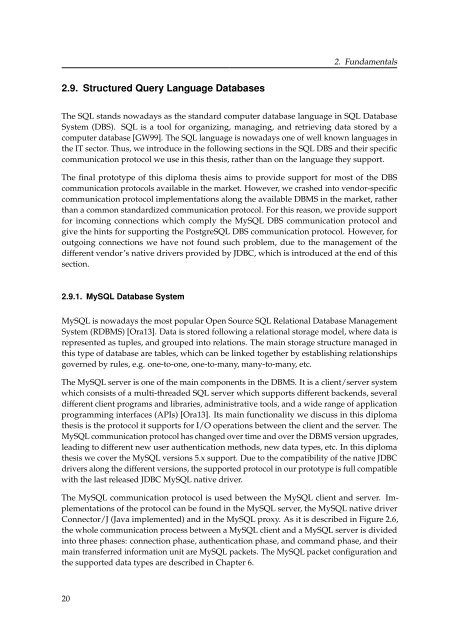Diploma Thesis Santiago Gómez Sáez - IAAS
Diploma Thesis Santiago Gómez Sáez - IAAS
Diploma Thesis Santiago Gómez Sáez - IAAS
Create successful ePaper yourself
Turn your PDF publications into a flip-book with our unique Google optimized e-Paper software.
2. Fundamentals<br />
2.9. Structured Query Language Databases<br />
The SQL stands nowadays as the standard computer database language in SQL Database<br />
System (DBS). SQL is a tool for organizing, managing, and retrieving data stored by a<br />
computer database [GW99]. The SQL language is nowadays one of well known languages in<br />
the IT sector. Thus, we introduce in the following sections in the SQL DBS and their specific<br />
communication protocol we use in this thesis, rather than on the language they support.<br />
The final prototype of this diploma thesis aims to provide support for most of the DBS<br />
communication protocols available in the market. However, we crashed into vendor-specific<br />
communication protocol implementations along the available DBMS in the market, rather<br />
than a common standardized communication protocol. For this reason, we provide support<br />
for incoming connections which comply the MySQL DBS communication protocol and<br />
give the hints for supporting the PostgreSQL DBS communication protocol. However, for<br />
outgoing connections we have not found such problem, due to the management of the<br />
different vendor’s native drivers provided by JDBC, which is introduced at the end of this<br />
section.<br />
2.9.1. MySQL Database System<br />
MySQL is nowadays the most popular Open Source SQL Relational Database Management<br />
System (RDBMS) [Ora13]. Data is stored following a relational storage model, where data is<br />
represented as tuples, and grouped into relations. The main storage structure managed in<br />
this type of database are tables, which can be linked together by establishing relationships<br />
governed by rules, e.g. one-to-one, one-to-many, many-to-many, etc.<br />
The MySQL server is one of the main components in the DBMS. It is a client/server system<br />
which consists of a multi-threaded SQL server which supports different backends, several<br />
different client programs and libraries, administrative tools, and a wide range of application<br />
programming interfaces (APIs) [Ora13]. Its main functionality we discuss in this diploma<br />
thesis is the protocol it supports for I/O operations between the client and the server. The<br />
MySQL communication protocol has changed over time and over the DBMS version upgrades,<br />
leading to different new user authentication methods, new data types, etc. In this diploma<br />
thesis we cover the MySQL versions 5.x support. Due to the compatibility of the native JDBC<br />
drivers along the different versions, the supported protocol in our prototype is full compatible<br />
with the last released JDBC MySQL native driver.<br />
The MySQL communication protocol is used between the MySQL client and server. Implementations<br />
of the protocol can be found in the MySQL server, the MySQL native driver<br />
Connector/J (Java implemented) and in the MySQL proxy. As it is described in Figure 2.6,<br />
the whole communication process between a MySQL client and a MySQL server is divided<br />
into three phases: connection phase, authentication phase, and command phase, and their<br />
main transferred information unit are MySQL packets. The MySQL packet configuration and<br />
the supported data types are described in Chapter 6.<br />
20

















